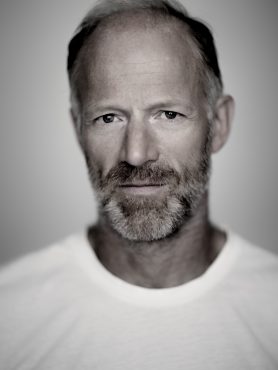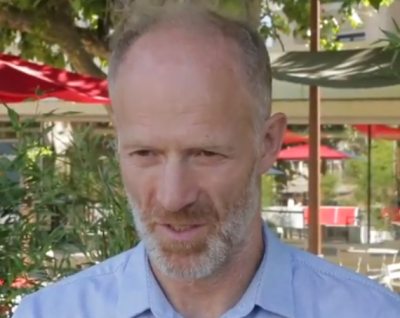Speaker
Børge OUSLAND
Polar explorer

With solo expeditions to both the South and North Poles and solo crossings of both the Antarctic and the Arctic from coasts to coasts, Børge Ousland is established as one of the leading polar explorer of our time.
Ousland grew up on Nesodden outside Oslo. He now lives in Oslo with his partner Hege Røgeberg. He has three children, Max, Eva-Liv and Ingeborg.
After high school Børge trained as a diver and worked from 1984 to 1993 as a saturation diver in the North Sea. In the period 1989 – 1991 Børge served his military service in the Norwegian Special Naval Forces.
In 1986 Børge and two of his diving colleagues, Agnar Berg and Jan Morten Ertsaas, skied across Greenland. In 37 days they travelled from Angmassalik on the east coast to Umanak on the west coast, a distance of 800 km in direct line. At that time only a few had travelled across the inland ice since Fridtjof Nansen and five companions first made the crossing in 1888.
The next expedition was in 1990 when Børge, Geir Randby and Erling Kagge set out from Ellesmere Island in Canada for the North Pole without receiving any supplies underway. Randby had to be picked up due to an injury, but Ousland and Kagge completed the trip in 58 days (March 8 to May 4, 1990). This was the first unsupported ski trek to the North Pole; a distance of 800 km.
Børge Ousland and Agnar Berg attempted in 1993 to ski across the drift ice from Frans Josef Land to Svalbard, but the expedition had to be aborted when they encountered large areas of open water.
Although the North Pole trip in 1990 had created a lot of interest in Norway and abroad, it was nothing compared to the attention created following his solo trek to the North Pole in 1994, also completed without any outside support. He started from Cape Arktichesky in Northern Siberia on March 2, 1994 and arrived at the North Pole 52 days later on April 22. This is was the first time anyone had reached the North Pole alone and without support. After successfully completing this expedition Børge Ousland has worked full time on expeditions and the tasks associated with these.
The next challenge was to be the first to cross Antarctica alone without support from coast to coast via the South Pole. In 1995 Ousland had to abandon this trip due to frost injuries after having passed the South Pole itself. Although he did not complete the crossing, he then became the first person to have skied alone without support to both poles.
The very next year, 1996-97, he successfully completed the first crossing of Antarctica, alone and without receiving any supplies underway. He started November 15 from Berkner Island in the Weddell Sea and he reached the McMurdo base by the Ross Sea on January 17. He had then been underway 64 days and covered a distance of 2845 km. The lowest temperature experienced was minus 56 degrees Celsius. At start the sledge weighed 178 kilos. The maximum altitude reached was about 3400 meter above sea level.
In 2001 Børge reached another milestone by becoming the first person who have crossed both poles. He crossed the Arctic Ocean alone from Siberia to Canada via the North Pole in 82 days.
Ousland has twice climbed mountains higher than 8000 meters in the Himalayas (Cho Oyo in 1999; in 2003 he had to turn back just below the peak of Mount Everest).
In 2002 Børge Ousland and Thomas Ulrich made a reconnaissance trip to Patagonia in Chile to study the area for a new expedition. Up to that point nobody had managed to cross the southern Patagonian Ice Field unsupported; the third largest glacier in the world after Antarctica and Greenland.
The following year the couple succeeded in crossing the Patagonian Ice Fields without outside support. The expedition started by kayak from Tortel, over the inland ice fields on skis and sled, and 54 days later they finally paddled to Puerto Natales in their kayaks. The combination of Thomas as a mountain climber and Børge as a polar veteran was very successful on this very difficult expedition that, for example, included a 600-meter rappel. The expedition was described in an article in National Geographic Magazine for August 2004. This was Børge’s third article in this magazine.
In 2006, Borge set out on one of his hardest expeditions, North Pole during wintertime. 22nd of January Borge and expedition partner Mike Horn left Cape Arktichesky and started the battle against the cold and darkness on the dangerous drifting ice. After more than two months, fighting open water, polar bears, minus 40 conditions and life threatening infections, they reached the Geographical North Pole 23rd of March.
1st of May 2007, Børge and expedition partner Thomas Ulrich set of from the North Pole to follow in Fridtjof Nansen’s historical expedition from 1895 through Frans Josef land. After one thousand kilometres on drifting ice, they reached the remote Eva-Liv Island. From here they followed the historical route through the archipelago until they reached Cape Flora, three months after they left the North Pole. Nansen’s journey is regarded as one of the most daring in polar history and for the first time someone has followed in his footsteps.
On 23rd of June 2010 Børge and skipper Thorleif Thorleifsson set out from Oslo on the “Northern Passage”, a 31 foot sailing trimaran made of fibreglass with a ten hp outboard as only engine. 14th of October they reached Norway again, being the first ever to circumnavigate the North Pole in one season. This is now possible due to the fast retreat of the Arctic sea ice. Completing this expedition Børge has shown with a concrete example what is happening in the Arctic due to climate changes.
In 2011 Børge completed another book, together with cowriter Thorleif Thorleifsson, based on the circumnavigation of the Arctic, and the TV-documentary “Northern passage” From the same expedition.
In 2012 Børge Ousland, together with Vincent Colliard from France, started the “Ice Legacy” project with the first crossing of Nordaustlandet in Svalbard, one of the largest glaciers in Europe,
With the Ice Legacy project (see www.icelegacy.com) Børge Vincent will cross all the 20 greatest glaciers in the world. They will focus on global warming; the importance of glaciers in the world’s climate, and also transferring Børges knowledge from decades of pushing the limits to a younger generation.
November 2013, Børge, Vincent and three teammates crossed the Southern Patagonian Icecap, the largest glacier in South America, from Jorge Mont in Chile to Paso Marconi in Argentina. In 2013, Børge receive the Spanish Geographical Society’s International award for his achievements in the polar regions.
In August 2014, Børge, Vince and two teammates crossed the Spitsbergen glacier on Svalbard, the third glacier so far in the Ice Legacy project.
In 2014 Børge also published his 9th book, the “expedition handbook”, with practical advices from his vast knowledge of polar exploration, equipment and outdoor life in general.
In May 2015 Vincent Colliard and Børge crossed the Stikine Icefield in Alaska, the third largest in US.
In April 2016 In May 2016 Vincent Colliard and Børge crossed the St Elias in Alaska, the largest in US.
In July-August 2017 Vincent Colliard and Børge went back to Alaska, and crossed the Chugach icefield, second largest in US. The crossing of the Alaskan glaciers is a part of the Icelegacy project.
In September – October 2018, Mike Horn and Børge Ousland will attempt another expedition across the North Pole, partly in the dark period. Sailing from Nome in Alaska, they will try to reach ice as far north as possible and from the ice edge continue with skis and kayaks across the North pole towards Svalbard.
Børge has managed to successfully complete his expeditions as a result of thorough preparation with emphasis on training, coordination and development of equipment and properly balanced nutrition.
Børge Ousland makes his living giving lectures and writing books. He is one of the few speakers represented by National Geographic Speakers Bureau; a part of the National Geographic Society, Washington, D.C. He has also held several lectures for the Royal Geographic Society in London. In 2014 Børge was elected as Fellow of the Royal Scottish Geographical Society, with title FRSGS.
Since 2013, Børge has also build up a tourist and conference centre on the Manshausen Island in the northern parts of Norway. www.manshausen.no
Books:
Umanak,1987
Alone to the North Pole, 1994
Alone across Antarctica, 1997 (Preface by Sir Edmund Hillary)
Alone across the North Pole, 2001 (Preface by Reinhold Messner)
Skrubbsulten, 2005
Il Solitairo dei poli (Italian Translation) 2005
Winter without mercy, 2006
Solo durch ewiges eis (German translation) 2007
The great polar journey, 2009, (First price, category adventure, in Banff Mountain book festival)
Northern passage (2011, Norwegian and English edition).
Expedition handbook (2014, Norwegian version so far).
Films:
The North Pole; Poles apart, 1991
Alone to the North Pole, 1994 (First prize in Dijon Adventure Film Festival)
Alone across Antarctica, 1997
The big white, 2001 (First prize in Moscow Adventure Film Festival and in Torello Mountain Film Festival).
Patagonia, A travel to the ends of the world, 2005 (First price in Bansko Mountain film festival, and Moscow adventure film festival).
In Nansen´s footsteps. 2009. (Jury special award in Bansko Mountain film festival).
Northern Passage, 2011.
National Geographic Magazine articles:
National Geographic Magazine, March 1991. The hard way to the North Pole
National Geographic Magazine, March 2001: Solo across the North Pole
National Geographic Magazine, August 2004: Big Ice
National Geographic Magazine, January 2007: Arctic dreams and nightmares
National Geographic Magazine, January 2009: Chasing Nansen´s ghost
Facebook Account:
https://www.facebook.com/borgeousland/
Copyright photo: © Pål Laukli





















































































